TONGAN FEAST
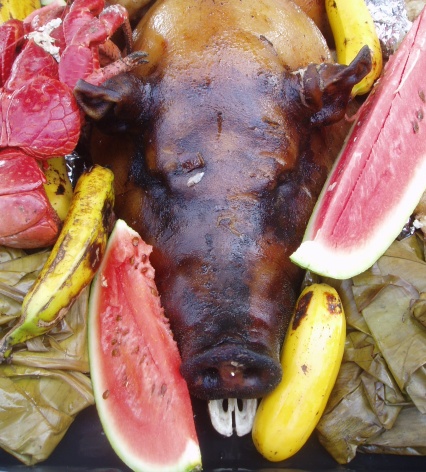
Roasted pig surrounded by fresh fruits and coconut crabs
From shortly after we arrived at Niuatoputapu, we heard about a planned feast on October 1. Sia is very involved in her church, St. Theresa’s, and the feast is an annual fundraiser for that church. However, we didn’t think we would still be on this island a month later, so we did not expect to attend. But October 1 came around, and we were still on island, so we attended along with most of the other cruisers in the anchorage.
Participating families prepared multilevel tables (called polas) of food and drink. The tables were approximately 12′ long by 3-4′ wide. Although they did not fit in the back of pick-up trucks, that is how they were transported with few casualties. The men helped unload them, then the women finished setting up.
Before arriving, the tables were covered and decorated in colorful paper. In addition to food and drinks on the tables, arching wire frameworks ran across the tables at about 3′ intervals and along each long side of the table. The wires were decoratively covered, and candies and treats were tied to them. There was no open space. Each was covered with netting until it was time to eat.
Each table was intended for the family who built it and their guests; however, anyone could sit at any table. Sia and Niko invited the cruisers, so Niko built two of these monsters. There were a total of 11 tables at this feast. There was a remarkable variety of foods laid out on each. There were local fruits and vegetables (we have never seen such huge taro roots!), plates of cooked foods (chicken, fish, etc), lobsters, coconut crabs, umu-cooked packages, pastries, and soft drinks. But the unavoidable attention-getters were the pigs. Each table had numerous roasted suckling pigs. Most tables had ten. If you do the math, that is more than 100 pigs, and there were more roasted pigs set aside in baskets just in case more were needed! There was a remarkable amount and variety of foods.
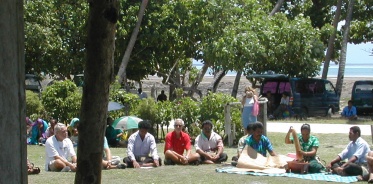
Formal kava ceremony before eating
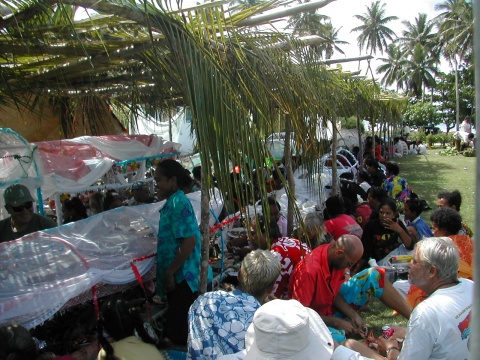
Table after table of food
Of course, there was kava. Before much got started, there was a small group of men sitting in the shade drinking kava while the women finished setting up. Then, before eating, there was a formal kava ceremony. And, after eating, there was more casual kava drinking (also fundraising) for the men.
Also, each family danced in a fundraising effort. Most of the families danced rather casually, and they offered their collected monies to the church. But one of Niko’s sisters did a dance that was in a league of its own. The dance is called tau’olunga. Tau’olunga is performed only for special occasions. It is usually a solo dance, but others, called tulafale, surround her and draw attention to her. Her skin is covered with coconut oil, and while she is dancing, others lay paper money on her skin. The money briefly sticks to the coconut oil, then falls to the ground. Her tulafale dancing around her pick up the money and offer it to the church.
In a much less artistic effort, one of Niko’s uncles somehow got most of the cruising men in a circle and was teaching them a traditional Tongan dance. The guys had lots of fun, and those watching had quite a laugh. Good sports having a good time.
At the end of the day, this one feast raised over $15,000 pa’anga. They had hoped to raise $7,000 pa’anga, so they raised more than double what they expected. Although the cruisers did not give excessive amounts of money, we were told that this day’s contributions from the cruisers far surpassed any from prior years. So it was a success as well as a very good time.
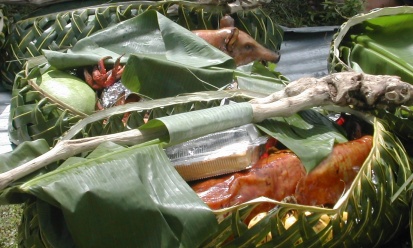
Just in case more food is needed
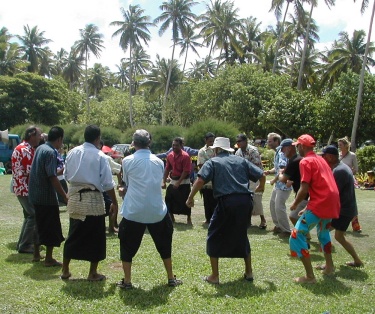
The (mostly) cruising men learning a Tongan dance the (mostly) cruising men learning a Tongan dance
Because there is no refrigeration on the island, we had to wonder what happened to all the food that was not eaten at the feast. We asked Niko. Each family loaded their left-over food in to a car or truck, and it was given to neighbors on the island that had not attended the feast. Consistent with their lifestyle, nothing was wasted.
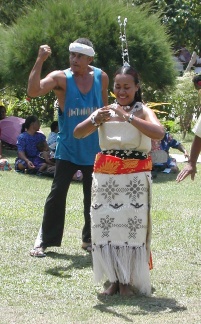
Dancing tau’olunga
Return to our page on Niuatoputapu.